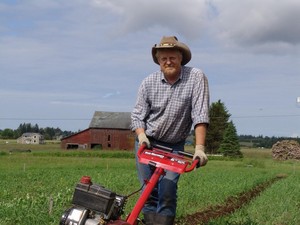08 Mar Tue 2011
Fertilizer Question
Recently, I received a question about using soymeal in my fertilizer mix. As I mentioned, there are pluses and minuses. Since 95% of soybeans grown in this country are GMO's, it is likely any soymeal you buy for your nitrogen source will be GMO soymeal. That's the minus. The plus is that there is likely to be less pesticide residue in feedgrade soymeal than in cottonseed meal, which is not even listed as feed for animals and so has fewer restrictions on pesticide use. If you still don't like the idea of using soymeal, here is your basic alternative - grow your own nitrogen.
The average soybean yield in the US is 50 bushels per acre and a bushel of soybeans weighs 60 pounds. This calculates to 3,000 pounds per acre. Since soymeal is generally 7% nitrogen, each acre of soybeans grown yields approximately 210 pounds of nitrogen per acre. This is enough for two years worth of corn, which needs around 100 pounds of nitrogen per acre - and even more for other, less demanding crops. By the way, 100 pounds per acre for corn is a compromise figure, as corn silage needs about 150 pounds of nitrogen per acre BUT you are not returning the stalks to the soil - unlike sweet corn or ear corn. On the other hand, some extension services say you need 1.5 pounds of nitrogen for each bushel of corn produced. For 200 bushels per acre (a maximum number and not likely for small-scale production) you would need 300 pounds per acre. However, the extension services are in thrall to the chemical companies so we should be wary of anything they recommend. We also know there is WAY too much fertilizer put on industrial ag fields and it flows down into the ocean, resulting in algae blooms the size of Delaware in the Gulf of Mexico, for instance. There is also nitrogen available in the soil. Even though 98% is in the organic form (and unavailable), the 2% that is available is still considerable. About 50 pounds available nitrogen per acre is not unreasonable. [By the way, I just used "organic" in the organic chemistry usage. I assume you can keep the two uses of "organic" straight.] All in all, shooting for 100 pounds of nitrogen added to your soil each year is a good compromise to both ensure soil fertility and do so in a non-wasteful manner (i.e. growing biomass is much preferable to pouring on chemicals or seed meal).
So, you can indeed grow your own nitrogen and then you won't have to worry about pesticides and GMO's from your supplier who may be halfway across the country or the world. The next trick is to make it part of your rotation. My rotation is a six-year rotation:
1) grain - barley, wheat, rye, spelt, triticale
2) soybeans or favas
3) root - potatoes, onions, carrots, beets, etc.
4) fruit - corn, tomatoes, squash, etc.
5) pea - peas, beans, soybeans, favas
1) grain - barley, wheat, rye, spelt, triticale
2) soybeans or favas
3) root - potatoes, onions, carrots, beets, etc.
4) fruit - corn, tomatoes, squash, etc.
5) pea - peas, beans, soybeans, favas
6) leaf - salad mix, cabbage, greens, etc.
Notice that in my rotation, there is one year for growing a legume and then two years for other crops. I don't put any fertilizer on my legume crops during that rotation and I depend on residual levels of phosphorus, potassium, sulfur, calcium, trace minerals, etc. to carryover. This fits in well with my overall scheme and gives me good yields. There are other advantages to this system, too. For example, growing grain conditions the soil. I can even grow a winter cover crop where I just had legumes, too, as this helps to "capture" the nitrogen produced during the legume crop (rather than being chewed up by microbes and contributing to methane in the atmosphere). I then go back to my rotation in the spring.
The upshot here is that you can grow your own nitrogen and this is one of my ongoing experiments. So far it works great.
Walter_1
11:50 AM PST

